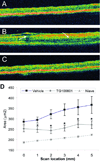Topical administration of a multi-targeted kinase inhibitor suppresses choroidal neovascularization and retinal edema
- PMID: 18330892
- PMCID: PMC3032767
- DOI: 10.1002/jcp.21426
Topical administration of a multi-targeted kinase inhibitor suppresses choroidal neovascularization and retinal edema
Abstract
Age-related macular degeneration, diabetic retinopathy, and retinal vein occlusions are complicated by neovascularization and macular edema. Multi-targeted kinase inhibitors that inhibit select growth factor receptor tyrosine kinases and/or components of their down-stream signaling cascades (such as Src kinases) are rationale treatment strategies for these disease processes. We describe the discovery and characterization of two such agents. TG100572, which inhibits Src kinases and selected receptor tyrosine kinases, induced apoptosis of proliferating endothelial cells in vitro. Systemic delivery of TG100572 in a murine model of laser-induced choroidal neovascularization (CNV) caused significant suppression of CNV, but with an associated weight loss suggestive of systemic toxicity. To minimize systemic exposure, topical delivery of TG100572 to the cornea was explored, and while substantial levels of TG100572 were achieved in the retina and choroid, superior exposure levels were achieved using TG100801, an inactive prodrug that generates TG100572 by de-esterification. Neither TG100801 nor TG100572 were detectable in plasma following topical delivery of TG100801, and adverse safety signals (such as weight loss) were not observed even with prolonged dosing schedules. Topical TG100801 significantly suppressed laser-induced CNV in mice, and reduced fluorescein leakage from the vasculature and retinal thickening measured by optical coherence tomography in a rat model of retinal vein occlusion. These data suggest that TG100801 may provide a new topically applied treatment approach for ocular neovascularization and retinal edema.
(c) 2008 Wiley-Liss, Inc.
Figures






Similar articles
-
Development of prodrug 4-chloro-3-(5-methyl-3-{[4-(2-pyrrolidin-1-ylethoxy)phenyl]amino}-1,2,4-benzotriazin-7-yl)phenyl benzoate (TG100801): a topically administered therapeutic candidate in clinical trials for the treatment of age-related macular degeneration.J Med Chem. 2008 Mar 27;51(6):1546-59. doi: 10.1021/jm7011276. Epub 2008 Feb 27. J Med Chem. 2008. PMID: 18311895
-
Targeting intraocular neovascularization and edema--one drop at a time.N Engl J Med. 2008 Aug 28;359(9):967-9. doi: 10.1056/NEJMcibr0804551. N Engl J Med. 2008. PMID: 18753655 No abstract available.
-
Antiangiogenic effect of dasatinib in murine models of oxygen-induced retinopathy and laser-induced choroidal neovascularization.Mol Vis. 2017 Nov 24;23:823-831. eCollection 2017. Mol Vis. 2017. PMID: 29225458 Free PMC article.
-
Anti-angiogenic effects of the receptor tyrosine kinase inhibitor, pazopanib, on choroidal neovascularization in rats.Eur J Pharmacol. 2011 Sep;666(1-3):12-8. doi: 10.1016/j.ejphar.2011.05.016. Epub 2011 May 20. Eur J Pharmacol. 2011. PMID: 21620822
-
Emerging therapies for the treatment of neovascular age-related macular degeneration and diabetic macular edema.BioDrugs. 2007;21(4):245-57. doi: 10.2165/00063030-200721040-00005. BioDrugs. 2007. PMID: 17628122 Review.
Cited by
-
Diabetic macular edema: current and emerging therapies.Middle East Afr J Ophthalmol. 2012 Jan;19(1):4-12. doi: 10.4103/0974-9233.92110. Middle East Afr J Ophthalmol. 2012. PMID: 22346109 Free PMC article.
-
Ophthalmic drug delivery systems for the treatment of retinal diseases: basic research to clinical applications.Invest Ophthalmol Vis Sci. 2010 Nov;51(11):5403-20. doi: 10.1167/iovs.10-5392. Invest Ophthalmol Vis Sci. 2010. PMID: 20980702 Free PMC article. No abstract available.
-
Characteristic findings of optical coherence tomography in retinal angiomatous proliferation.Korean J Ophthalmol. 2013 Oct;27(5):351-60. doi: 10.3341/kjo.2013.27.5.351. Epub 2013 Sep 10. Korean J Ophthalmol. 2013. PMID: 24082773 Free PMC article.
-
Antiangiogenic effects of topically administered multiple kinase inhibitor, motesanib (AMG 706), on experimental choroidal neovascularization in mice.J Ocul Pharmacol Ther. 2015 Feb;31(1):25-31. doi: 10.1089/jop.2014.0023. J Ocul Pharmacol Ther. 2015. PMID: 25255037 Free PMC article.
-
Inhibition of choroidal neovascularization by topical application of angiogenesis inhibitor vasostatin.Mol Vis. 2009 Sep 18;15:1897-905. Mol Vis. 2009. PMID: 19768130 Free PMC article.
References
-
- Armulik A, Abramsson A, Betsholtz C. Endothelial/pericyte interactions. Circ Res. 2005;97:512–523. - PubMed
-
- Brown DM, Kaiser PK, Michels M, Soubrane G, Heier JS, Kim RY, Sy JP, Schneider S, Group AS. Ranibizumab versus verteporfin for neovascular age-related macular degeneration. N Eng J Med. 2006;355:1432–1444. - PubMed
-
- Campochiaro PA. Retinal and choroidal neovascularization. J Cell Physiol. 2000;184:301–310. - PubMed
-
- Campochiaro PA. Ocular neovascularisation and excessive vascular permeability. Expert Opin Biol Ther. 2004;4:1395–1402. - PubMed
MeSH terms
Substances
Grants and funding
LinkOut - more resources
Full Text Sources
Other Literature Sources
Miscellaneous

